Hardwick Hall, "More Glass Than Wall"
by Julia Hickey
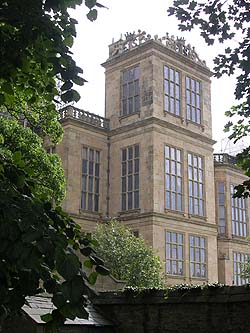 Ascend the hill towards the dramatic silhouette
on the Derbyshire skyline. Here, looking towards the patchwork
hills of the Peak District, is Hardwick Hall, an icon of Tudor
architecture. The ruins of the nearby Old Hall are an imposing
reminder of earlier times. Both buildings are part of the legacy
left by a singleminded Derbyshire lass: Elizabeth, Countess of
Shrewsbury, who began life as plain Bess of Hardwick. Ascend the hill towards the dramatic silhouette
on the Derbyshire skyline. Here, looking towards the patchwork
hills of the Peak District, is Hardwick Hall, an icon of Tudor
architecture. The ruins of the nearby Old Hall are an imposing
reminder of earlier times. Both buildings are part of the legacy
left by a singleminded Derbyshire lass: Elizabeth, Countess of
Shrewsbury, who began life as plain Bess of Hardwick.
Her mark is upon everything, from the grand ES turrets that
proclaim her ownership of the glittering symmetrical sandstone
Hall to the curling Cavendish snakes that twist around the lead
drainpipes. The house is her creation and her monument. It took
just seven years to build following the death of her estranged
husband and one-time gaoler to Mary Queen of Scots -- the Earl of
Shrewsbury -- in 1590.
Pass through the portals of the porter's lodge into a walled
garden. Its symmetry mirrors the house and it doesn't seem to
matter what the season is, for the gardeners always provide a
riot of color and texture. Walk up the path to the wide porch
with its tapering columns. It is often possible to encounter a
Tudor housekeeper here. In the summer months she relates tales of
Bess of Hardwick, who seemed driven to create the most
magnificent house in the kingdom. Little wonder she was also
called "the costly countess."
Proceed into the baronial hall dominated by Bess's coat of arms
supported by two stags, cross the creamy flags and take in the
assorted weaponry, mounted stags heads, enormous hearth and long
oak table with matching benches. This room is not only the main
entrance, but harks back to a time when servants were part of the
household dining in the hall, sleeping in the same rooms or near
their masters and mistresses rather than being kept below stairs. All of it is presided over by a portrait of Bess.
Study the delightful patchwork screens before continuing out of
the hall. The images are created from a rich patchwork of
velvets, silks and cloth of gold. Much of the material comes
from medieval ecclesiastical vestments. The colour and the
detail can only be maintained by carefully controlled lighting.
It is for this reason that Hardwick, despite the number of
windows it boasts, seems dimly lit. The needlework collection
here is of national importance -- indeed, the screens are perhaps
the most important part of the collection as they represent a
complete set of Tudor hangings. All kinds of needlework
techniques and fabrics are on display throughout the house --
many examples worked by Bess herself, others by her embroiderer
called Webb. Visitors must also wonder how Beth must have been
influenced by the other great Tudor needlewoman, Mary Queen of
Scots.
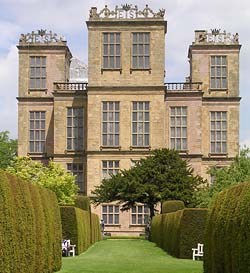 Take
advantage of the Threads of Time exhibition housed in the
ground floor nursery to see some of the needlework in more
detail, learn about the techniques that created the golden
caterpillars and butterflies that decorate much of the furniture
and find out how important the symbolism contained in the
tapestries was to Beth and her contemporaries. It is perhaps of
no surprise that much of Bess's needlework portrays family crests
and it is not hard to imagine hawk-eyed Bess selecting tapestries
from Brussels that she believed told her own story and celebrated
her own characteristics. Take
advantage of the Threads of Time exhibition housed in the
ground floor nursery to see some of the needlework in more
detail, learn about the techniques that created the golden
caterpillars and butterflies that decorate much of the furniture
and find out how important the symbolism contained in the
tapestries was to Beth and her contemporaries. It is perhaps of
no surprise that much of Bess's needlework portrays family crests
and it is not hard to imagine hawk-eyed Bess selecting tapestries
from Brussels that she believed told her own story and celebrated
her own characteristics.
Continue through the Evidence Room, where countless wooden boxes
are filled with documents detailing every aspect of Bess's
kingdom, and into a room dominated by a partially completed
hanging. Take advantage of a book or audio commentary to
discover the fascinating process from selecting and creating a
design to the countless hours of painstaking stitchery required
for a finished piece.
Walk through twisting hallways partitioned by sturdy doors fitted
with stout bolts and heavy locks to the broad stair case that
sweeps majestically up to the first floor landing and Bess's
private chapel. The arras in the chapel is as bright as the day
it was made. It is also possible from the careful seating
arrangements to see the significance that the Countess and her
descendants placed on social hierarchy. Pause on the continuing
upwards climb to admire the great glass lantern with its panes of
bull's eye glass -- it is probably the fitting mentioned in the
1601 inventory -- before continuing a stately progress to the
second floor and the magnificent great High Chamber.
This room is fit for a queen. The plasterwork frieze tells the
story of Diana the huntress -- a deliberate reference Queen
Elizabeth -- so it is possible that Bess intended that the room
be ready for a visit from her monarch. However, she herself sat
beneath the canopy with her feet on the footstool whilst her
attendants held court balanced on the needlework covered stools
around the room. The other significant feature is the Elizabeth
looking glass -- an expensive rarity. Clearly Bess had a sense
of her own importance and wanted other people to recognise her as
a wealthy and independent woman -- the queen of her own little
kingdom.
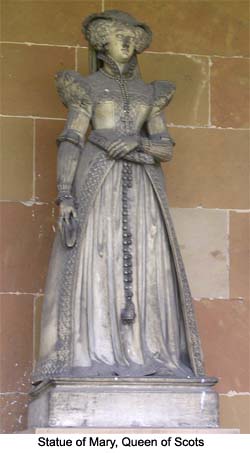 Duck through the door hidden by
tapestries to enter the Great Hall. Like the previous chamber,
it is carpeted by rush matting of the kind that Bess would have
recognised. The sweet smell of oats and meadowland lift the
atmosphere in these two rooms on the dreariest of days. The hall
is lined with portraits of Tudor, Jacobean and Carolinian
nobility. Mary Queen of Scots stares down at chattering school
children who gather beneath her picture. Her beauty is fading --
a consequence of her captivity. Despite the portrait and the
statue to the rear of the house, Mary never visited Hardwick.
There is only one piece of needlework in the hall that can be
directly ascribed to her, but it is well documented that in the
early days of Shrewsbury's wardenship Mary and Bess sat and
stitched together. Sadly the friendship withered as Mary grew
steadily more disquietened by Bess's overwhelming ambition and
the pressure of caring for the royal prisoner put a strain on the
Shrewsbury marriage best illustrated perhaps by the fact that the
earl is buried in Sheffield Cathedral whilst Bess -- ever the
builder -- is buried in Derby, commemorated by a monument of her
own design. Duck through the door hidden by
tapestries to enter the Great Hall. Like the previous chamber,
it is carpeted by rush matting of the kind that Bess would have
recognised. The sweet smell of oats and meadowland lift the
atmosphere in these two rooms on the dreariest of days. The hall
is lined with portraits of Tudor, Jacobean and Carolinian
nobility. Mary Queen of Scots stares down at chattering school
children who gather beneath her picture. Her beauty is fading --
a consequence of her captivity. Despite the portrait and the
statue to the rear of the house, Mary never visited Hardwick.
There is only one piece of needlework in the hall that can be
directly ascribed to her, but it is well documented that in the
early days of Shrewsbury's wardenship Mary and Bess sat and
stitched together. Sadly the friendship withered as Mary grew
steadily more disquietened by Bess's overwhelming ambition and
the pressure of caring for the royal prisoner put a strain on the
Shrewsbury marriage best illustrated perhaps by the fact that the
earl is buried in Sheffield Cathedral whilst Bess -- ever the
builder -- is buried in Derby, commemorated by a monument of her
own design.
Further along the great Hall is a picture of James I of England
as a young boy, and at the far end of the hall Queen Elizabeth I
keeps watch. Many of the other portraits are of Bess's family.
Her first marriage was childless; her second marriage was to an
older man who was smitten by her beauty and sold his estates to
buy land in Derbyshire and Nottinghamshire. This union was
probably Bess's happiest and it was the one that gave her
children. These children sired the lines of the Duke of
Devonshire, Newcastle and Portland. However, it was on her
grand-daughter Arbella Stuart that Bess pinned the hopes for her
family. It is also worth noting a portrait of an elderly
gentleman -- Thomas Hobbes -- was tutor to the 2nd and 3rd Dukes
of Devonshire. He died at Hardwick in 1679.
The tour continues through a warren of rooms with overmantels,
panels, distinctive furnishings and tapestries depicting
historical and mythical stories. The Green Velvet Room is large
and splendidly furnished with a massive 18th-century four-poster
bed. On the other side of this room is a tiny chamber that could
once be found in Chatsworth. When the old house at Chatsworth
was torn down to be replaced by the present house, this room was
dismantled and carted through the valleys of Derbyshire to
Hardwick. The room belonged to Mary Queen of Scots. In this
chamber stands the bed that she once slept in. It is very
heavily restored and there is no evidence to suggest that she
worked the designs on the hangings. Despite its change in
location there is no doubt that everything about the room is
authentic.
Pass through more winding corridors, down the North staircase --
a rather less grand wooden structure -- back to the first floor.
The dining room is ready for an 18th-century banquet. Further on
the drawing room has an 18th-century interior and displays family
photographs. As ever in this house the Hardwick stags are given
prominence. Look for the touching picture of a little girl in
Elizabeth dress. She is clutching her doll and staring through
the frame with a serious expression her face. This wide eyed
child in her richly embroidered dress with her gold necklace is
Lady Arbella Stuart.
 At the time this portrait was painted Arbella was two
years old and her grandmother's delight. The cunning countess
had taken advantage of a meeting between her daughter Elizabeth
Cavendish and Charles Lennox (Lord Darnley's brother). The pair
had been married. Queen Elizabeth's wrath was so great that
Lennox's mother had been sent to the Tower. Somehow Bess managed
to escape similar punishment. Sadly for Arbella, she was orphaned
soon after her birth and passed into the care of Bess. Little
Arbella had a claim to the throne. The scene was set for a
tragedy. Bess was determined to capitalise on Arbella's heritage. At the time this portrait was painted Arbella was two
years old and her grandmother's delight. The cunning countess
had taken advantage of a meeting between her daughter Elizabeth
Cavendish and Charles Lennox (Lord Darnley's brother). The pair
had been married. Queen Elizabeth's wrath was so great that
Lennox's mother had been sent to the Tower. Somehow Bess managed
to escape similar punishment. Sadly for Arbella, she was orphaned
soon after her birth and passed into the care of Bess. Little
Arbella had a claim to the throne. The scene was set for a
tragedy. Bess was determined to capitalise on Arbella's heritage.
Arbella's bed chamber is a suite of rooms designed for a future
queen. Poor Arbella grew up in a confined atmosphere. She was
closely watched by her grandmother. She even slept in Bess's
room. For Arbella, Hardwick was a prison. Sadly Arbella escaped
into an inadvisable marriage and from there back into
imprisonment -- this time in the Tower of London on the orders of
James I, her cousin. The bonny little girl in the portrait
starved herself to death in 1615 after enduring years of
imprisonment. She is buried in Westminster Abbey with Mary Queen
of Scots; her aunt by marriage would have understood the mental
anguish of prolonged imprisonment.
Return through the house and down another set of stairs. A heady
aroma of food fills the air. Don't worry -- these are not the
ghostly manifestations of an old house. The kitchen with its
pewter plates, copper pans, kettles and scales has been
transformed into a restaurant serving locally inspired food. The
Bakewell tart and custard is a real treat, as is the treacle
sponge pudding that evokes cold winter evenings of childhood.
There's just as much to see outside the house. The gardens are
tranquil, lined with carefully maintained yew and holly hedges.
Wander through the herb garden and inhale the scents of mint,
thyme and lavender or admire brightly coloured tulips, irises,
poppies, roses and chrysanthemums, depending upon the season.
Continue along manicured avenues towards the house or relax in
the orchards. A small summerhouse provides a brief display
outlining the development of gardens four hundred years in the
making. A final garden at the back of the house mirrors the one
visitors first see on their entrance through the porters lodge.
The views lead towards an avenue of distant trees. Walk through
the opening in the hedge to take a closer look at the ha-ha. This
is a clever device to make it look as if the garden stretches out
into the surrounding countryside. The grazing sheep are
prevented from nibbling roses and borders by a wall that drops
into a ditch out of sight of the garden's genteel visitors.
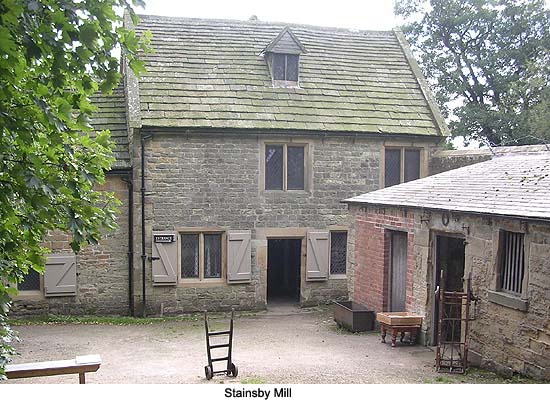
It is also possible to visit the stone mason's yard. Hardwick
has its own quarry further down the hill. Find out how the grand
old house is maintained through the loving care of a team of
dedicated masons. And why not explore the parklands? Traces of
earthworks dating from the eleventh century can be seen in the
slopes below the hall, but as ever it is Bess's stamp that
dominates the scenery. Extensive ponds filled with water lilies
and wild life once provided the hall with a plentiful supply of
fish.
Virtually everything required for the building of Hardwick came
from Beth's estates; her self-sufficiency is well documented, so
why not round off the visit with a stop at Stainsby mill also
owned by the National Trust? A mill has stood on this site since
the Middle Ages. Its great waterwheel still turns the mill
stones and flour is still produced just as it once was for the
countess's tenants.
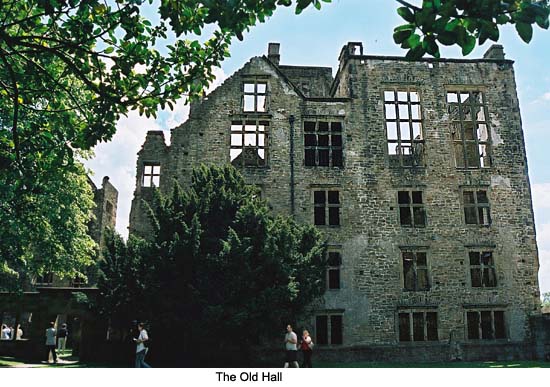
Before venturing to Stainsby don't forget to take a look at
the Old Hall. It is in the care of English Heritage. In Bess's
time it wasn't a ruin. She built upon and extended her childhood
home before beginning work on the new hall. The whole site was
one vast complex, the Old Hall housing servants and visitors.
Explore the empty rooms and climb the stairs to the chamber
containing the plasterwork figures of Gog and Magog. You'll be
following in the footsteps of Queen Victoria, who is said to have
surprised her entourage by reaching this point in the old
building before any of them.
Summer visitors wishing to make a full day of their excursion to
Hardwick can make use of the Heritage Coach Service -- a 1940's
bus -- which runs between Chesterfield, Bolsover Castle, Sutton
Scarsdale Hall, Stainsby Mill and Hardstoft Herb Garden on
Sundays, bank holidays and Thursdays. Other places to visit near
Hardwick include Chatsworth House and historic Chesterfield with
its famous twisting spire -- definitely worth a stop.
Visitors wishing to find out more about Mary Queen of Scots
should visit Wingfield Manor and Tutbury Castle. Chatsworth
House is much changed from the place Mary would have known
however her arbour and a hunting lodge may still be viewed here.

More Information:
We regret that we no longer have the resources to maintain up-to-date links and/or hours and pricing details for the various sites and attractions listed on this website. For more information about the location(s) listed above, please use your favorite search engine or visit Wikipedia.
Julia Hickey is passionate about England's heritage and particularly of Cumbria, where her husband comes from. In between dragging her family around the country to a variety of historic monuments, she works part-time as a senior lecturer at Sheffield Hallam University. She spends the rest of her week writing. In her spare time, she enjoys walking, dabbling in family history, cross-stitch, tapestry and photography.
Article © 2006 Julia Hickey; Photos © 2006 Adam Hewgill
| 